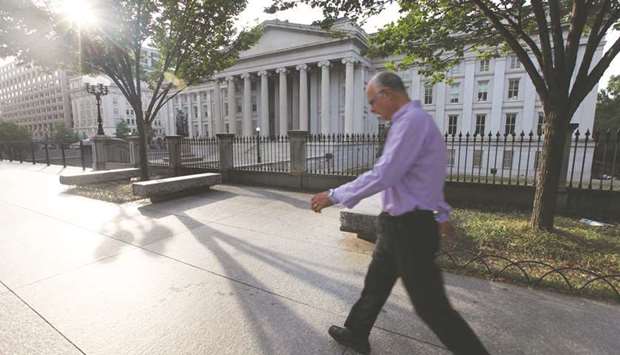The Fed may raise its benchmark rate as many as four times next year as US economic growth quickens and wages pick up, said Mark Dowding, co-head of investment grade and a senior portfolio manager of BlueBay in London. Policy makers may tighten even more if the Republican Party can deliver on its promised tax cuts, which is likely to be the case, he said.
“The market is really underpricing the Fed’s trajectory,” said Dowding, who oversees nearly half of the company’s $57.2bn of assets under management, in an interview in Tokyo. “The market is only discounting one or maybe one to one-and-a-half moves in Fed rates in 2018. We think that the Fed may hike three or four times next year. So a much more aggressive forecast on the Fed than the market.”
Treasuries have handed investors a loss of 0.3% over the three months through Thursday, according to the Bloomberg Barclays US Treasury Index. European sovereign debt has returned 0.8% in the same period. The benchmark 10-year Treasury yield was at 2.36% yesterday, up from as low as 2.01% in September.
House Republicans on Thursday passed legislation to overhaul the US tax code by cutting the corporate tax rate. The Senate is debating its own separate plan, and it isn’t yet clear the chamber will have enough votes to pass it.
“These tax cuts will actually imply a fiscal easing into an economy that’s already at full employment and growing above trend,” Dowding said. “So when you think about this from the Fed perspective, this will mean that they will probably need to adopt an even more restrictive policy next year than they are already considering.”
Investors should prefer debt in Europe as the region’s central bank will leave rates at a record low until 2019, while political risks have also been receding, Dowding said.
“European yields will probably rise by less because of the anchor of cash rates holding bond yields down, so relatively speaking we like European bonds compared to US bonds,” he said. “We see no rate hike in Europe until the middle or late part of 2019. With this being the case, the front end of the curve is anchored.”
The European Central Bank said in October it would reduce monthly bond-purchases volumes to €30bn ($35.4bn), half the current pace, starting in January and extend buying at that amount through September 2018. President Mario Draghi promised to maintain interest rates near zero for as long as necessary.
Here are Dowding’s views on other major markets:
UK: Brexit is in a mess as there’s no clear negotiations taking place. Prime Minister May is in a very weak position, while the risk of “no deal” in hard Brexit is growing, which will damage the economy. Sterling has lost about 15% against the euro since the Brexit vote but may fall even further. Bearish view for both gilts and the pound.
Japan: Wages and prices are rising, but Prime Minister Abe isn’t expected to declare victory in the fight against deflation for another 12 months. BoJ policy has been very successful in restraining volatility, while making the bond market very boring. This policy has been benefiting the economy and is expected to continue for at least another 12 months. BoJ’s yield curve control will continue to keep the benchmark 10-year yield in a range of zero to 0.1%.
Emerging markets: BlueBay has been constructive all through 2017 in emerging markets, but moved to a more cautious position a few weeks ago. Reflation trade is expected to resume in 4Q amid likelihood of progress in US tax reform by year-end. Reflation trade may push up volatility in bonds and across all markets, which could make things difficult for risk assets. Emerging markets may be exposed, particularly if the dollar strengthens.
A pedestrian passes in front of the US Treasury building in Washington, DC (file). The benchmark 10-year Treasury yield was at 2.36% yesterday, up from as low as 2.01% in September.



